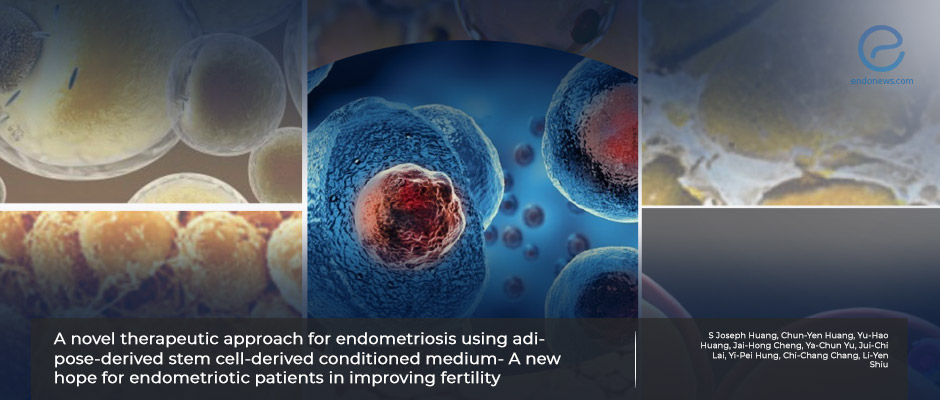Conditioned medium from adipose tissue derived stem cells for endometriosis treatment
Jul 13, 2023
Promising results in treating endometriosis and improving fertility
Key Points
Highlight:
- Conditioned medium collected from adipose-derived stem cells (ADSC-CM) shows therapeutic potential for endometriosis treatment.
Importance
- Understanding the effects of ADSC-CM on endometriosis development and its mechanisms of action can pave the way for the development of targeted therapies to enhance our understanding of the underlying pathophysiology of the disease.
What's done here
- Using a mouse model of endometriosis, the researchers evaluated the effects of ADSC-CM on the development of endometriotic lesions.
- The ADSCs and a conditioned medium prepared from ADSC (ADSC-CM) were characterized, and safety issues were controlled.
- Endometriosis lesion development, histology, gene expression, and pregnancy outcomes were evaluated using either or both along with a control medium.
Key results
- ADSC-CM significantly reduced the size of endometriotic lesions.
- The inhibitory effect on lesion development was observed when using ADSC-CM alone, but the addition of ADSCs counteracted this effect.
- ADSC-CM showed a suppressive effect on the expression of ICAM-1 and VEGF.
- ADSC-CM also enhanced endometrial receptivity in the eutopic endometrium of mice with endometriosis, upregulating the expression of receptivity markers.
- Proteomic analysis of ADSC-CM identified various proteins and pathways associated with its therapeutic effects.
Lay Summary
Despite the effectiveness of both surgical and medical treatments in addressing complications related to endometriosis, there is still a high recurrence rate indicating the need for the development of novel therapeutic approaches to enhance the effectiveness of endometriosis treatment. Adipose-derived stem cells (ADSCs) from adipose tissue have shown therapeutic potential in organ repair and exhibit beneficial effects in regulating inflammation and promoting wound healing. Huang et al. from Taiwan and the United States conducted a study aiming to explore the effects of human ADSC-conditioned medium (ADSC-CM) on endometriosis using a mouse model. The results of the study were published in the May 2023 issue of the journal Frontiers in Endocrinology.
An endometriosis mouse model was created by suturing uterine tissues to the peritoneal wall and mice were treated with either a control medium (control), a conditioned medium that was produced from ADSCs (ADSC-CM), or the combination of ADCS and the conditioned medium that was produced from ADSCs (ADSC+ADSC-CM). Adhesion band formation and lesion size were assessed. Histopathological analysis was performed using hematoxylin and eosin staining. Gene expression analysis was conducted, and the effects of ADSC-CM on eutopic endometrial receptivity and pregnancy outcomes were also evaluated.
The results revealed that ADSC-CM significantly reduced the endometriotic lesions compared to the controls. However, when ADSCs were added along with ADSC-CM, the inhibitory effect on lesion development was abolished. Interestingly, ADSCs alone did not show any inhibitory effect on lesion development. These findings may suggest the secreted factors in ADSC-CM play a key role in the therapeutic effect observed, the authors stated.
Further analysis revealed that ADSC-CM suppressed the expression of ICAM-1 and VEGF, which are known to be involved in inflammation and angiogenesis, in endometriotic lesions. The addition of ADSCs counteracted this suppression, indicating a potential regulatory role of ADSCs in the expression of these factors. ADSC-CM also improved pregnancy outcomes in mice with endometriosis suggesting a positive impact on reproductive outcomes in endometriosis. Additionally, it also enhanced endometrial receptivity in the eutopic endometrium of mice with endometriosis. It upregulated the expression of receptivity markers such as LIF, HOXA10, and HOXA11. Furthermore, ADSC-CM also reduced immune cell infiltration in the eutopic endometrium and promoted the expression of receptivity markers in the epithelium, stroma, and glands.
It is concluded that the findings provide valuable insights into the mechanisms underlying these therapeutic effects and suggest that ADSC-CM could be a promising option for the treatment of endometriosis. Further studies are needed to validate these findings.
Research Source: https://pubmed.ncbi.nlm.nih.gov/37293500/
endometriosis adipose-derived stem cells conditioned medium

